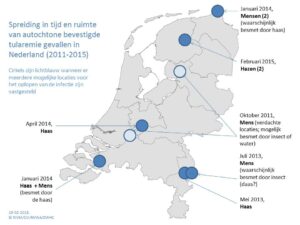Tularemia also found in hares in Friesland
Friesland is the fifth province in which tularemia has been found in hares. Two hares from the centre of the province were submitted to the Dutch Wildlife Health Centre (DWHC) for post-mortem exam. Tularemia was initially suspected based on lesions seen in the liver and was later confirmed by molecular tests performed at the Central Veterinary Institute (CVI) in Lelystad.
These two cases, the first of 2015, bring the total number of tularemia-positive hares to five since the start of the tularemia screening program in 2011 (see map).
© RIVM/CVI/NVWA/DWHC
In the Netherlands a tularemia study group has been set up with representatives from a range of wildlife and public health organisations including the RIVM, GGD, CVI, DWHC and NVWA. The group performs research and risk analyses and produces information for use by medical and veterinary professionals and at-risk groups such as hunters.
Tularemia in people
Tularemia in humans is very rare. People can become infected via contact with animals (in particular hares and rodents) but the bacteria is not transmitted from person to person. The most common routes of infection include:
- Via the skin e.g. small wounds or insect bites
- Ingestion of insufficiently cooked infected meat; the bacteria can be killed by heating to at least 60°C.
- Consumption of contaminated surface water
Preventative measures
In the countryside protect yourself from biting insects with products or appropriate clothing. Gloves should always be worn when handling animal carcasses and wounds should be thoroughly disinfected and covered.
Reporting a dead hare
You can report finding one or more dead hares (or other animals) in the wild, via the submission form on our website. After submitting your form you will be contacted by the DWHC who will help to decide whether or not further investigation is necessary and will advise you on how to package the cadaver and arrange collection of the package from your home or place of work.
Further information
Further information about this condition in humans and animals is available on the website of the OIE.



